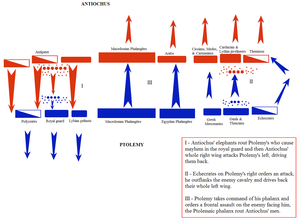Battle of Raphia
| Battle of Raphia | |||||||
|---|---|---|---|---|---|---|---|
| Part of the Fourth Syrian War | |||||||
 |
|||||||
|
|||||||
| Belligerents | |||||||
| Ptolemaic Egypt | Seleucid Empire | ||||||
| Commanders and leaders | |||||||
| Ptolemy IV of Egypt | Antiochus III the Great | ||||||
| Strength | |||||||
| 70,000 infantry, 5,000 cavalry, 73 elephants |
62,000 infantry, 6,000 cavalry, 102 elephants |
||||||
| Casualties and losses | |||||||
| 1,500 infantry, 700 horse, 16 elephants killed, almost 26 captured | 10,000 infantry, 300 horse and 5 elephants killed, 4,000 infantry captured | ||||||
The Battle of Raphia, also known as the Battle of Gaza, was a battle fought on 22 June 217 BC near modern Rafah between the forces of Ptolemy IV Philopator, king and pharaoh of Ptolemaic Egypt and Antiochus III the Great of the Seleucid Empire during the Syrian Wars. It was one of the largest battles of the Hellenistic kingdoms and was one of the largest battles of the ancient world. The battle was waged to determine the sovereignty of Coele Syria.
The two largest of the Hellenistic kingdoms, Ptolemaic Egypt and the Seleucid Empire, were bitter enemies, and repeatedly fought for control of Syria. These were the Syrian Wars. The Fourth Syrian War began in 219 BC Ptolemaic Egypt was ruled by Ptolemy IV, and the Seleucid Empire was ruled by Antiochus III the Great. By 217 BC, Antiochus and the Seleucid army advanced through Syria. Ptolemy’s self interests led his ministers, advisors and generals to make serious preparations. Both kingdoms disputed Syria. The Seleucid and Ptolemaic armies met near the small Syrian town of Rafah. Antiochus initially set up his camp at a distance of 10 (about 2 km) and then only 5 stades (about 1 km) from his adversary's. Many skirmishes took place before the battle due to this proximity. One night, Theodotus the Aetolian, formerly an officer of Ptolemy, sneaked inside the Ptolemaic camp and reached what he presumed to be the King's tent but Ptolemy was absent and so failed to assassinate him.
According to Polybius, Ptolemy had 70,000 infantry, 5,000 cavalry, and 73 war elephants and Antiochus 62,000 infantry, 6,000 cavalry, and 102 elephants.
Antiochus' army was composed of 5,000 light armed Daae, Carmanians and Cilicians under Byttacus the Macedonian, 10,000 Phalangites (the Argyraspides or Silver Shields) under Theodotus the Aetolian, the man who had betrayed Ptolemy and handed much of Coele Syria and Phoenicia over to Antiochus, 20,000 Macedonian Phalangites under Nicarchus and Theodotus Hemiolius, 2,000 Persian and Agrianian archers and slingers with 2,000 Thracians under Menedemus of Alabanda, 5,000 Medes, Cissians, Cadusii and Carmanians under the Aspasianus the Mede, 10,000 Arabians under Zabdibelus, 5,000 Greek mercenaries under Hippolochus the Thessalian, 1,500 Cretans under Eurylochus and 1,000 Neocretans under Zelys the Gortynian, 500 Lydian javelineers and 1,000 Cardaces (Kardakes) under Lysimachus the Gaul.
...
Wikipedia
